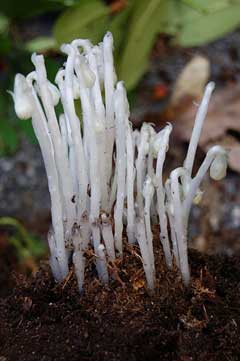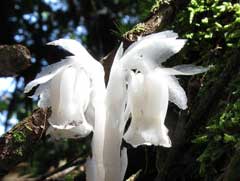 |
|
|
 |
| http://www.flickr.com/people/63518505@N00 |
Translate this page:
Summary
Physical Characteristics

 monotropa uniflora is a PERENNIAL growing to 0.2 m (0ft 8in). It is in flower from July to September. The species is hermaphrodite (has both male and female organs).
monotropa uniflora is a PERENNIAL growing to 0.2 m (0ft 8in). It is in flower from July to September. The species is hermaphrodite (has both male and female organs).
Suitable for: light (sandy), medium (loamy) and heavy (clay) soils. Suitable pH: mildly acid, neutral and basic (mildly alkaline) soils. It can grow in full shade (deep woodland) or semi-shade (light woodland). It prefers moist soil.
UK Hardiness Map
US Hardiness Map
Synonyms
Plant Habitats
Woodland Garden Dappled Shade; Shady Edge; not Deep Shade;
Edible Uses
Edible Parts: Leaves
Edible Uses:
The whole plant can be cooked[177]. It is tasteless if eaten raw, but has a taste like asparagus when it is cooked[105].
References More on Edible Uses
Medicinal Uses
Plants For A Future can not take any responsibility for any adverse effects from the use of plants. Always seek advice from a professional before using a plant medicinally.
Antibacterial Antispasmodic Epilepsy Febrifuge Hypnotic Nervine Odontalgic Ophthalmic
Sedative Tonic Warts
An infusion of the root is antispasmodic, hypnotic, nervine, sedative, tonic[21, 192, 222]. It is a good remedy for spasms, fainting spells and various nervous conditions[207]. It has been given to children who suffer from fits, epilepsy and convulsions[257]. The plant was used by some native North American Indian tribes to treat eye problems, the stem was bruised and the clear fluid of the stems applied to the eyes[213, 257]. The juice from the stems has also been used to treat nervous irritability, including fits and spasms[192]. It has been suggested in the past as a possible opium substitute[192]. An infusion of the leaves has been used to treat colds and fevers[257]. The crushed plant has been rubbed on bunions and warts in order to destroy them[257]. A poultice of the plant has been applied to sores that are difficult to heal[257]. The flowers have been chewed in order to bring relief from toothache[257]. Water extracts of the plant are bactericidal[222].
References More on Medicinal Uses
The Bookshop: Edible Plant Books
Our Latest books on Perennial Plants For Food Forests and Permaculture Gardens in paperback or digital formats.

Edible Tropical Plants
Food Forest Plants for Hotter Conditions: 250+ Plants For Tropical Food Forests & Permaculture Gardens.
More

Edible Temperate Plants
Plants for Your Food Forest: 500 Plants for Temperate Food Forests & Permaculture Gardens.
More

More Books
PFAF have eight books available in paperback and digital formats. Browse the shop for more information.
Shop Now
Other Uses
References More on Other Uses
Cultivation details
We have very little information on this plant but it should be hardy in this country. It is likely to require shady woodland conditions in a humus-rich moist soil, It is a saprophytic plant, quite devoid of chlorophyll and depending totally on its host plant for nutrient[1].
References Carbon Farming Information and Carbon Sequestration Information
Temperature Converter
Type a value in the Celsius field to convert the value to Fahrenheit:
Fahrenheit:
The PFAF Bookshop
Plants For A Future have a number of books available in paperback and digital form. Book titles include Edible Plants, Edible Perennials, Edible Trees,Edible Shrubs, Woodland Gardening, and Temperate Food Forest Plants. Our new book is Food Forest Plants For Hotter Conditions (Tropical and Sub-Tropical).
Shop Now
Plant Propagation
This is going to be an exceedingly difficult plant to propagate. The seed will need to be sown close to its host plant so one way would be to sow it in the leaf litter under established beech or coniferous trees[1]. Alternatively, you could try sowing the seed in a cold frame in a pot that already contains a potential host plant. If successful, grow the young plant on in the cold frame for a couple of years before planting it out close to an established beech or coniferous tree.
Other Names
If available other names are mentioned here
Native Range
TEMPERATE ASIA: China (Anhui Sheng, Gansu Sheng, Guizhou Sheng, Hubei Sheng, Hunan Sheng, Jiangxi Sheng, Qinghai Sheng, Shaanxi Sheng, Shanxi Sheng, Sichuan Sheng, Xizang Zizhiqu, Yunnan Sheng, Zhejiang Sheng), Japan (Hokkaidô (south), Honshu, Kyushu, Shikoku), Taiwan TROPICAL ASIA: Bhutan, India, Nepal, Vietnam NORTHERN AMERICA: United States (Alaska, Connecticut, Indiana, Maine, Massachusetts, Michigan, New Hampshire, New Jersey, New York, Ohio, Pennsylvania, Rhode Island, Vermont, West Virginia, Iowa, Kansas, Minnesota, Missouri, Nebraska, North Dakota, Illinois, Oklahoma, Wisconsin, Idaho, Montana, Oregon, Washington, Alabama, Arkansas, Florida, Georgia, Kentucky, Louisiana, Maryland, Mississippi, North Carolina, South Carolina, Tennessee, Virginia, Texas, California), Canada (Québec, Nova Scotia, Ontario, Prince Edward Island, New Brunswick, Newfoundland and Labrador, Saskatchewan, Alberta, Manitoba, British Columbia), Mexico (Chiapas SOUTHERN AMERICA: Costa Rica, Honduras, Nicaragua, Panama, Colombia
Weed Potential
Right plant wrong place. We are currently updating this section.
Please note that a plant may be invasive in one area but may not in your area so it's worth checking.
Conservation Status
IUCN Red List of Threatened Plants Status :

Growth: S = slow M = medium F = fast. Soil: L = light (sandy) M = medium H = heavy (clay). pH: A = acid N = neutral B = basic (alkaline). Shade: F = full shade S = semi-shade N = no shade. Moisture: D = dry M = Moist We = wet Wa = water.
Now available:
Food Forest Plants for Mediterranean Conditions
350+ Perennial Plants For Mediterranean and Drier Food Forests and Permaculture Gardens.
[Paperback and eBook]
This is the third in Plants For A Future's series of plant guides for food forests tailored to
specific climate zones. Following volumes on temperate and tropical ecosystems, this book focuses
on species suited to Mediterranean conditions—regions with hot, dry summers and cool, wet winters,
often facing the added challenge of climate change.
Read More
Expert comment
Author
L.
Botanical References
158235
Links / References
For a list of references used on this page please go here
Readers comment